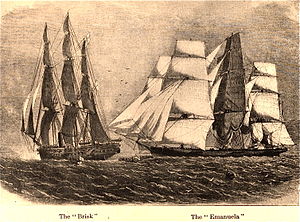Sunny South (clipper)

Capture of slave ship Emanuela by HMS Brisk
|
|
| History | |
|---|---|
|
|
|
| Name: | Sunny South |
| Owner: | Napier, Johnson & Co, New York City |
| Builder: | George Steers and Co, Williamsburg, NY |
| Cost: | $70,000 |
| Launched: | Sept. 7, 1854 |
|
|
|
| Acquired: | Sold to Havana, 1859; left Havana Mar. 5, 1860, under Chilean flag |
| Renamed: | Emanuela or Manuela |
| Captured: | 10 August 1860, by HMS Brisk, with 846 slaves aboard |
| Status: | Condemned as a prize, sold to British Navy |
|
|
|
| Name: | Enchantress |
| Fate: | Wrecked in the Mozambique Channel, Feb. 20, 1861 |
| Status: | Used as store ship on African coast |
| General characteristics | |
| Class and type: | Extreme clipper |
| Tons burthen: | 776 tons |
| Length: | 154 ft., or 135 ft. 4 in. |
| Beam: | 31 ft. 4 in., or 30 ft. 4 in. |
| Draft: | 16 ft. 6 in., or 17 ft. 3 in. |
Coordinates: 13°02′53″S 45°11′42″E / 13.048°S 45.195°E
Sunny South, an extreme clipper, was the only full-sized sailing ship built by George Steers, and resembled his famous sailing yacht America, with long sharp entrance lines and a slightly concave bow. Initially, she sailed in the California and Brazil trades. Sold in 1859 and renamed Emanuela (or Manuela), she was considered to be the fastest slaver sailing out of Havana. As Emanuela, she was captured off the coast of Africa in 1860 with over 800 slaves aboard, taken as a prize, and converted into a Royal Navy store ship, Enchantress.
Sunny South was built for the China trade, but she was too small to be profitable on that route. The timbers of her wooden hull were somewhat lighter than usual for a ship of her size, and diagonally strapped with iron. Sunny South's topsides were black, and a scaly sea serpent was her figurehead.
A description of her launch (7 September 1857) in the New York Times stated that a large number of people were in attendance, and praised her beauty and fine sailing characteristics, as was characteristic of press coverage of that time.
On her maiden voyage in 1854, Sunny South made a 143-day passage from New York to San Francisco under Capt. Michael Gregory, putting in at Rio de Janeiro. She made unusually good time in the Pacific on this passage between the Equator and the Golden Gate. She then sailed to Hong Kong in ballast in 51 days, with a 102-day return passage to New York City, arriving in January 1856.
...
Wikipedia
